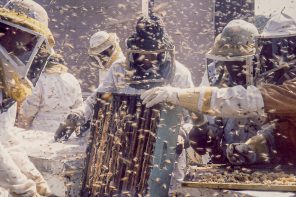Avoid Tank Mixing Insecticides with Fungicides.
Not all fungal diseases can be controlled by fungicides.
By: Michele Colopy
Fungicides (according to the Merriam-Webster dictionary pronounced \ˈfən-jə-ˌsīd, or ˈfəŋ-gə-\) are used to combat fungi. “Fungicides are used to control disease during the initial development of the plant; to reduce blemishes on plants, and improve the storage life and quality of the harvested crop.” Not all fungal diseases can be controlled by fungicides including vascular plant diseases. When used properly, fungicides only protect from a new infection, they do not generally “cure” a current fungus. “Curative” fungicides tend to “have a higher risk of pathogens developing resistance to the fungicide.”(2) In an Integrated Pest Management program, an “economic threshold is used to determine when fungicide treatment is needed.”(3) “Coverage of all parts of the plant susceptible to the disease is critical because very few fungicides can move adequately throughout a plant. For many diseases, effective control necessitates multiple applications of fungicides, sometimes as frequently as every five days. Repeated applications are needed to protect new growth and to replace fungicide lost from the plant by chemical decomposition, UV-light degradation, and erosion by wind and water.”(4)
Fungicides are “applied to:
- Seed, bulbs, roots of transplants, and other propagative organs.
- Soil either in-furrow at planting, after planting as a soil drench (including through drip irrigation), or as a directed spray around the base of the plant.
- Foliage and other aboveground parts of plants by means of a sprayer.
- Inside of trees via trunk injection.
- Air in enclosed areas such as greenhouses and covered soil
- Harvested produce, as a dip or spray in the packinghouse.”(5)
“Fungicides kill fungi by damaging their cell membranes, inactivating critical enzymes or proteins, or by interfering with key processes such as energy production or respiration. Others impact specific metabolic pathways such as the production of sterols or chitin.”(6)
At the end of almond bloom last year many colonies suffered due to a tank mix in some orchards. Last year the main culprit was a tank mix which included a fungicide. The Almond Board BMPs for growers advises “Avoid applying insecticides during almond bloom until more is known, particularly about their impact on bee brood (young developing bees in the hive). If treatment is necessary, only apply fungicides and avoid tank-mixing insecticides with fungicides.”(7) (Almond Board’s emphasis). They continue to advise, “Any fungicide application deemed necessary during bloom should occur in the late afternoon or evening when bees and pollen are not present. This timing avoids contaminating pollen with spray materials.”(8) (Again, the bold-faced type is the Almond Board’s emphasis.) These guidelines, however, are still “Best Management Practices,” and in the end are voluntary guidelines.
Fungicides are often viewed as relatively nontoxic to honey bees, however research has found “an increased probability of Nosema infection in bees that ate pollen with a higher fungicide load.”(9) In one study, researchers found 35 different pesticides in the pollen samples all with high fungicide loads. Other research detected “121 different pesticides and metabolites within 887 wax, pollen, bee and associated hive samples. Almost 60% of the 259 wax and 350 pollen samples contained at least one systemic pesticide, and over 47% had both in-hive acaricides fluvalinate and coumaphos, and chlorothalonil, a widely-used fungicide. In bee pollen were found chlorothalonil at levels up to 99 ppm and the insecticides aldicarb, carbaryl, chlorpyrifos and imidacloprid, fungicides boscalid, captan and myclobutanil, and herbicide pendimethalin at 1 ppm levels.”(10) In the study, Four Common Pesticides, Their Mixtures and a Formulation Solvent in the Hive Environment Have High Oral Toxicity to Honey Bee Larvae found “chronic dietary exposure to a fungicide, pesticide mixtures, and a formulation solvent have the potential to impact honey bee populations, and warrants further investigation. We suggest that pesticide mixtures in pollen be evaluated by adding their toxicities together, until complete data on interactions can be accumulated.”(11)
“Fungicides may enter the hive when applied to nearby flowering crops. Acaricides, antimicrobial drugs and fungicides are not highly toxic to bees alone, but in combination there is potential for heightened toxicity due to interactive effects.”(12) “Laboratory bioassays based on mortality rates in adult worker bees demonstrated interactive effects among acaricides, as well as between acaricides and antimicrobial drugs and between acaricides and fungicides.”(13) “The sterol biosynthesis inhibiting (SBI) fungicide prochloraz elevated the toxicity of the acaricides tau-fluvalinate, coumaphos and fenpyroximate, likely through inhibition of detoxicative cytochrome P450 monooxygenase activity. Four other SBI fungicides increased the toxicity of tau-fluvalinate in a dose-dependent manner, although possible evidence of P450 induction was observed at the lowest fungicide doses.”(14)
“Some fungicides are demonstrably toxic to bee larvae. Exposure of larvae to pollen containing Captan®, Ziram®, or iprodione led to 100 percent mortality (Alarcón 2009). Fungicides may also have synergistic effects when combined with other pesticides, or miticides applied by the beekeeper, making either more toxic to the bees.”(15) “Interactions with acaricides in honey bees are similar to drug interactions in other animals in that P450-mediated detoxication appears to play an important role. Evidence of non-transivity, year-to-year variation and induction of detoxication enzymes indicates that pesticide interactions in bees may be as complex as drug interactions in mammals.”(16) “A scary thing about fungicide contamination is that there may be a delayed effect – one may not notice problems until the bees dig back into stored pollen months after exposure!”(17) “When bees ferment pollen into beebread, they count on the right microbes to do the job. Honey bees have a long evolutionary involvement with beneficial symbiotic bacteria and fungi, and several of them appear to be associated with the health and nutrition of colonies. When a fungicide (or possibly an antibiotic) is inadvertently added to the pollen, we simply do not know whether the “normal” fermentation process will take place, or whether the chemicals will allow toxin-producing microbes to thrive. The entombment of pollen may simply be the way that bees deal with beebread “gone bad” so that the nurse bees don’t suffer from “food poisoning.”(18)
The Pollinator Stewardship Council continues to encourage additional research on the effects of tank-mixing of pesticides. Academic researchers have also expressed the need for this research. Our honey bees and native pollinators, are not experiencing just one pesticide: research needs to examine the real-world experience and effects of pesticides upon pollinators.
Research needs to:
- Expand the testing of insecticides that are the targets of most current research to ALL insecticides;
- Test pre-lethal effects of pesticides;
- Review the modes of action of pesticides;
- Look at additive and synergistic effects between multiple pesticides;
- Examine the lethal and pre-lethal effects of fungicides on honey bees; and,
- Research the “pesticide-pesticide and pesticide-disease synergistic effects.”
Pesticides are registered by the Environmental Protection Agency based on a single active ingredient. Tank mixes of pesticides are not reviewed/approved/regulated/monitored by EPA at the federal or state level. Dead honey bees (brood, adults, queen) are most often the result of additive and synergistic effects of pesticides. The economic benefit of tank-mixing to make one application of pesticides in the field, may cause an economic loss to the beekeeper. This is the “additive” effect of tank mixes upon commercial beekeepers.
Resources:
(1) What are Fungicides?, McGrath, M.T. 2004. The Plant Health Instructor. DOI: 10.1094/PHI-I-2004-0825-01
(2) Ibid.
(3) Ibid.
(4) Ibid.
(5) Ibid.
(6) Ibid.
(7) Honey Bee Best Management Practices Quick Guide for Almonds, 2014 Almond Board of California, www.Almonds.com/BeeBMPs
(8) Ibid.
(9) Crop pollination exposes honey bees to pesticides which alters their susceptibility to the gut pathogen Nosema ceranae, http://www.ars.usda.gov/research/publications/publications.htm?SEQ_NO_115=293497
(10) High Levels of Miticides and Agrochemicals in North American Apiaries: Implications for Honey Bee Health, www.plosone.org/article/info%3Adoi%2F10.1371%2Fjournal.pone.0009754
(11) Four Common Pesticides, Their Mixtures and a Formulation Solvent in the Hive Environment Have High Oral Toxicity to Honey Bee Larvae, www.plosone.org/article/info%3Adoi%2F10.1371%2Fjournal.pone.0077547
(12) Acaricide, Fungicide and Drug Interactions in Honey Bees (Apis mellifera), http://www.plosone.org/article/info%3Adoi%2F10.1371%2Fjournal.pone.0054092
(13) Ibid.
(14) Ibid.
(15) Fungicides, http://scientificbeekeeping.com/the-future-pesticides-and-fungicides/
(16) Acaricide, Fungicide and Drug Interactions in Honey Bees (Apis mellifera), www.plosone.org/article/info%3Adoi%2F10.1371%2Fjournal.pone.0054092
(17) Fungicides, http://scientificbeekeeping.com/the-future-pesticides-and-fungicides/
(18) Ibid.
Additional resources:
Fungicide Resistance Action Committee (FRAC) (http://www.frac.info/frac/index.htm)
Appendix II of a US Environmental Protection Agency (EPA) document (www.epa.gov/opppmsd1/PR_Notices/pr2001-5.pdf)
Fungicide chemical information can be found at www.pesticideinfo.org.
How to Reduce Bee Poisoning From Pesticides http://pesticidestewardship.org/PollinatorProtection/Documents/How%20to%20Reduce%20Bee%20Poisoning%20from%20Pesticides_PNW.pdf








